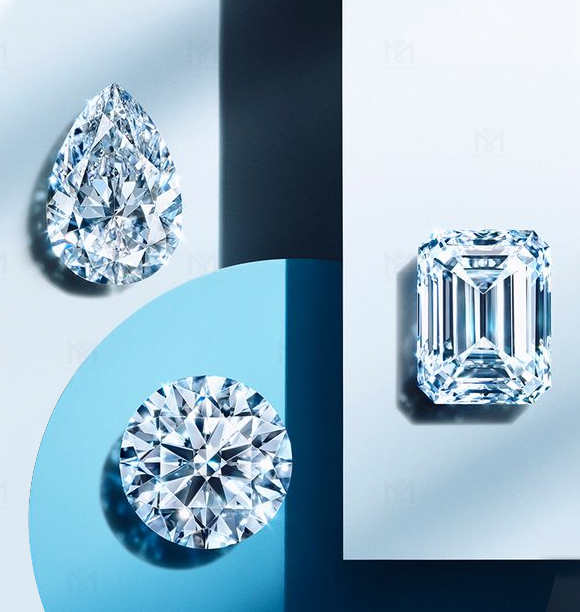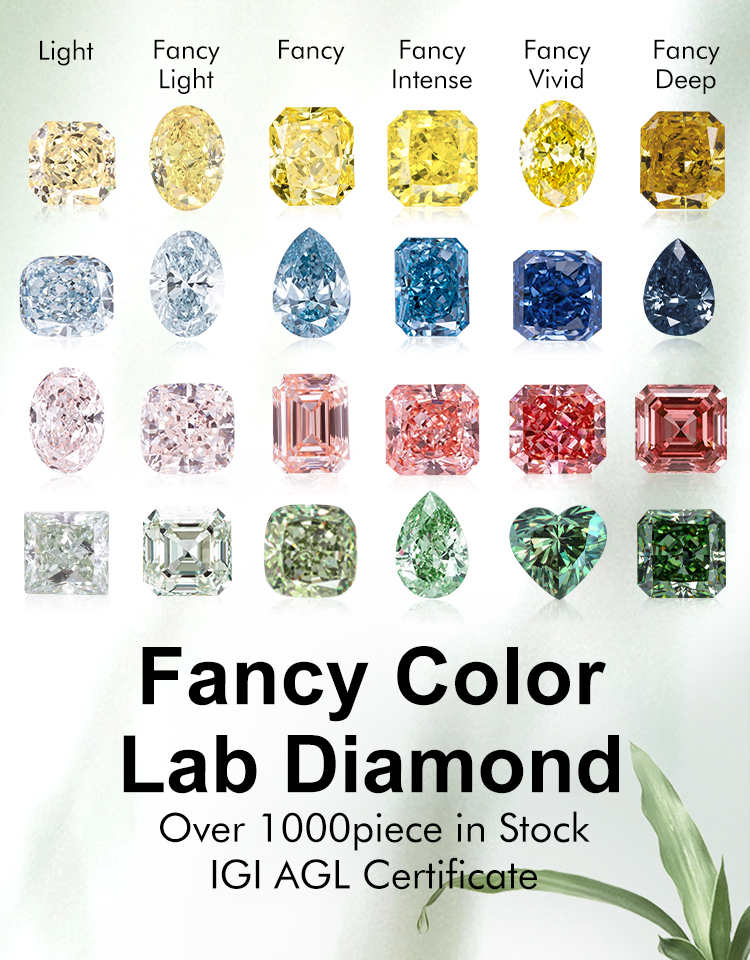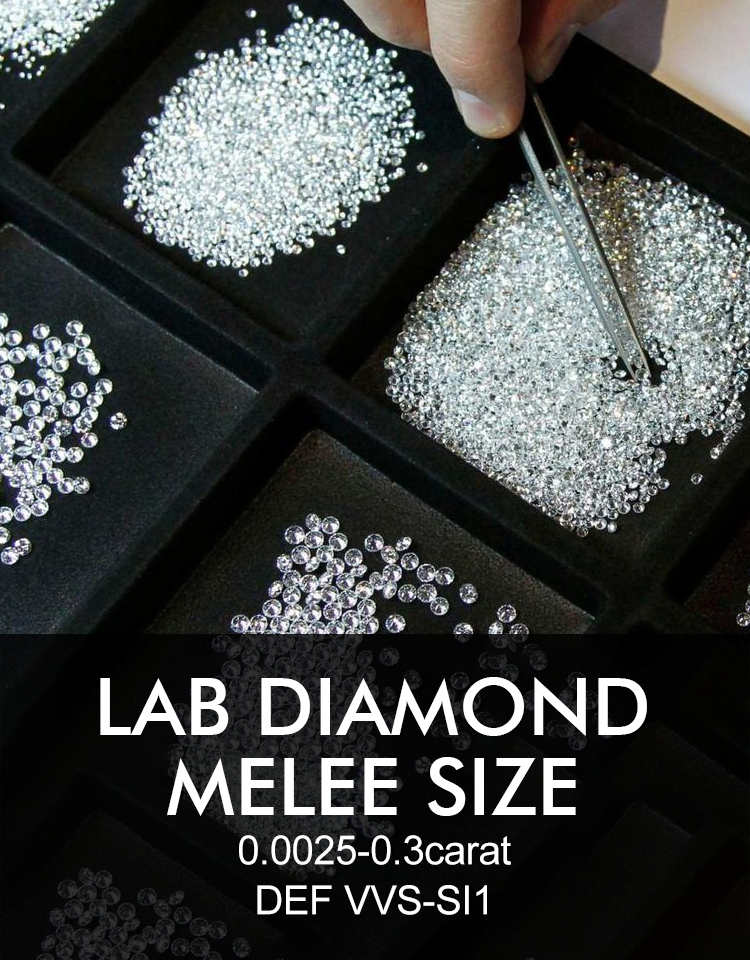
1. What exactly are lab grown diamond?
lab grown diamond are produced in laboratories where the environment in which natural diamonds are formed is recreated using advanced techniques and equipment, and small diamond seeds are used to induce natural crystallization of the diamonds, producing diamonds on the surface with physical, chemical and optical properties identical to those of natural diamonds. Therefore, lab grown diamond are real diamonds.
Someone once drew an analogy: comparing a natural diamond with a cultured diamond is like comparing a natural baby with a baby born to a surrogate mother; after all, they are all human beings!
Like people, diamonds are divided into beauty and ugliness. Beautiful, will be sent to go to high-end jewelry stores, become the most striking existence; looks average, will be packaged and polished a little in the ordinary people's families, witness love and life; ugly, most of the factory to do abrasive. So how are diamonds graded?
1-1. Diamond Type
As you should know, diamonds are made up of carbon atoms. Diamonds are roughly divided into four main types: Type Ia, Type Ib, Type IIa, Type IIb (1a, 1b, 2a, 2b), of which 1a accounts for 98% of the total amount of diamonds mined worldwide, 2a accounts for less than 2%, and there are very few natural 1b and 2b.
1a: Nitrogen impurities, low quality, various forms of impurities will affect the color of the diamond itself, so there will be colorless, yellowish, brown and so on a variety of colors, generally according to the quality of the use of the decision, can be used for jewelry, industry and so on.
1b: Nitrogen impurities are abundant, but the nitrogen contained is in monatomic form, resulting in an overall yellow color, ranging from dark to light. There are very few natural diamonds of this type in stock, but the HPHT factory in China produces them on a daily basis, covering more than 90% of the world's production capacity. Synthetic diamonds of this type are used as cutting tools or abrasives.
2a: Good stuff. Almost free of nitrogen inclusions, so it has good light transmission and most of the color is good, almost colorless, but can have a brownish tint. Many of the largest and most famous diamonds, such as the 33.19 carat Elizabeth Taylor Diamond, the 530 carat Cullinan 1, and the 317 carat Cullinan 2, are type 2a. Colorless CVD-grown diamonds are Type 2a.
2b: Blue Diamond. Diamonds appear blue due to the addition of the element boron. Naturally beautiful blue diamonds are rare and are cultivated for use in jewelry and are often used in semiconductor research for their electrical conductivity.
It should be emphasized that the inclusions mentioned here are atomic level inclusions that are invisible to the naked eye, and are not the same as the inclusions that can be seen with a magnifying glass as mentioned in diamond grading reports in stores.
Type 2a is so rare, there is a market for growing Type 2a diamonds.
1-2. Diamond Growth Methods
There are two commercially available methods for the mass production of diamonds: Chemical Vapor Deposition, or CVD, and High Pressure High Temperature, or HPHT.
1-2-1. CVD
Diamond as a crystal seed substrate, through the hydrogen and methane-based gas mixture, in the high temperature and low pressure conditions, hit the microwave energy, methane is hit with free carbon, a little rain fell on the crystal seed, according to the diamond template provided by the crystal seed is neatly arranged, little by little, the thicker and thicker, diamonds will grow. Doesn't that sound simple? In fact, can trigger this reaction formula interval is very narrow, it is difficult to find the right pressure, temperature, gas ratio, etc., if you do not find a good, the growth of diamond is brown, there will be black carbon, or simply failed.
Even if scientists find this interval perfectly, diamonds are capricious, and diamonds born in the same pot may have different growth conditions: brown or white, tall or short, spotted or dotted. External factors also have a great influence on the stability of the power supply, the purity of the gas, the quality of the crystal seed, the temperature of the environment, etc. So the diamonds are cultivated by scientists. So the diamonds are grown under the care of scientists, and each one is special.
Depending on the thickness of the diamond, the time it takes for the diamond to grow is different; the quality of the diamond also affects the growth rate, and high-quality diamonds naturally grow slower. Generally, the rough diamonds are ready for the pot after a few hundred hours.
The rough is then processed into loose diamonds, which can be approximately 5 carats.
1-2-2. HPHT
There are several different machines for HPHT, all with a similar principle of creating a high temperature, high pressure environment in the center of the machine that is capable of pressing raw carbon powder into diamonds.
A metal catalyst is required in between, so many HPHT diamonds will contain metal impurities.
In the early days, only small yellow particles could be produced and used as industrial abrasives; as technology advances, many domestic manufacturers can produce large colorless particles with fewer and fewer metal inclusions, reaching jewelry grade.
Domestic production capacity is mainly concentrated in the cut loose diamond weight of 1 carat or less. There is one in Russia that once grew a large diamond of 10 carats after cutting, but this kind of large particles are one in a million, and currently cannot be produced.

Fancy color lab diamond
1-3. Differences from Mined Diamonds
The only difference between lab grown diamond and mined diamonds is the source; one comes from a laboratory and the other is dug out of the ground.
There is no difference in appearance Oh, not after high-tech precision instrument identification is absolutely indistinguishable. Therefore, it is recommended to buy diamonds must be identified certificate.
1-4. Certification
Most of today's cultivated diamonds are certified by the International Gemmological Institute (IGI). Each cultured diamond has a unique code, LGxxxxxxxxxxxxxx, engraved on the band of the diamond.
Why not GIA? GIA can also produce, but it can be a little mood-altering. 99% of GIA's business comes from natural diamond appraisal, and natural diamond dealers look at the cultivation of diamonds is not good, how can less than 1% of the business for the sake of offending the big customers?
But as a "fair" third party, can not blatantly diss the cultivation of diamonds, so we have to do a little specialization in the cultivation of diamonds on the report: for example, an F-color VS1 grade diamonds, GIA appraisal report for colorless VS grade. However, we need to know that colorless includes three kinds of DEF, VS includes VS1 and VS2 two kinds, GIA only vaguely tell you the approximate range, this report is both expensive and unclear. Therefore, we all go to another authoritative organization IGI, at least there can be treated equally and accurately graded.
1-4-1. FTC Statement
In July 2018, the US Federal Trade Commission (FTC) revised its definition of diamonds and came out in favor of lab grown diamond. According to the statement, it is no longer correct to define a diamond as "natural" if a laboratory can create a product that has the same physical, chemical, and optical properties as a mined diamond, because both are diamonds. The FTC also advised practitioners to avoid using the term "synthetic" to refer to lab grown diamond, which can be misleading to consumers.
2. Advantages and Disadvantages of lab grown diamond
What are the benefits of cultivating diamonds?
- Environmentally friendly. No need for massive destruction of terrain, ecology.
- Conflict free. Guaranteed sources: no child labor, exploitation, terrorist organizations, blood diamonds, pollution and other inhumane situations.
- All Type IIa, high quality. Equivalent to the top 2% of the world's diamonds.
At this point, you're probably saying, "What does this have to do with me? Well, here's the kicker: the prices are low, folks. With the money you save, you can buy your daughter-in-law a Cartier bracelet, a Gucci bag, and the lucky guy can even get himself an entry-level luxury watch!
If your wife says, "Do you think our love should be discounted? Then be honest and give your budget with both hands. But for the same budget, buying lab grown diamond can buy diamonds of the same color and clarity of 2 carats or more. May I ask, what beautiful woman can resist the temptation?
Cons: Okay, I'll admit that there is a downside to lab grown diamond, and that is that they come from a lab, which seems to lack a bit of romance.
But it depends on each person's point of view, love, whether it is worn by diamonds or by his savings card, you couples may be able to discuss it.
Another drawback is that there is a size limit: CVD will be limited to the size of the crystal seed, high-quality large crystal seeds can not be found; HPHT will be limited to the limit of equipment to withstand, any increase in the growth of a little space, the capacity of the machine is a challenge.
3. Development History
2012 - lab grown diamond are officially out in the open, but in a negative light: shady natural diamond dealers are mixing and selling lab grown diamond with natural diamonds. Many labs were unable to detect lab grown diamond at all.
2013-2015 - The image is slowly changing, but unfortunately the supply is too small and the impact is limited, especially in the US, where suppliers are slowly making their presence felt at trade shows. Many major jewelers are aware of the situation, but no major moves are made for fear of affecting the millions of natural diamonds in stock. Diamond mining companies have spared no effort to discredit and combat lab grown diamond in order to protect the status of natural diamonds.
2016-2017 - Domestic HPHT white small pellets entered the mass production stage, Indian cutting and polishing factories stocked up in large quantities, confusing producers who thought the sales channel was open, so they produced large quantities. Unfortunately, the market did not open up, no one on the consumer side took over, prices went through the roof, and once again people were on edge. The momentum in the U.S. is good, the demand is slowly rising to more than 1 carat.
2018 - Known as the year of the cultured diamond, it was loud and strong, although prices fell (from 70-80% of natural to 50-60%).
In May, De Beers announced the launch of Lightbox, a brand of lab grown diamond in September, and announced a flat price of $800 per carat for diamonds under 1 carat, and their marketing director declared at the launch event that synthetic diamonds are not valuable, not necessary to grade, not suitable for important occasions, and no shame to lose them. what?!!!! This is what a marketing director says about his new brand and its positioning? Anyway, De Beers has a clear goal (maybe): If I can't control you, I'll destroy you!
In July, the Federal Trade Commission changed the definition of a diamond to give the aforementioned lab grown diamond a proper name, and Swarovski announced that it was reorganizing its cultured diamond line into the high-end Atelier Swarovski line.
In August, the former chairman of Russia's Alrosa (currently the world's number one natural diamond producer) announced that he was joining the cultured diamond brigade to create his own brand.
In September, Lightbox opened, except that 1 carat was never in stock. Many companies that had been afraid to get involved in diamond farming under the intimidation of De Beers began to slowly move.
October saw a massive influx of money into CVD diamond producers to expand capacity and increase exposure. Many cultured diamond brands came out of the woodwork to release new products.
In November, the Veep show used 2,100 lab grown diamond supplied by Swarovski to create the million-dollar Fantasy Bra.
In December, a "Full Grown Diamond" ring designed by Apple's chief design officer sold for $256,000 at a Sotheby's auction on December 5 (RED).
In January 2019, several CVD cultured diamond manufacturers each announced investments/change of ownership/expansion, the former CEO of Dominion Diamond in Canada (top 5 in the mined diamond world) announced the launch of a cultured diamond brand, and Prince Harry's wife Meghan wore cultured diamond jewelry.
In March 2019, Frederick Goldman purchased the cultivated diamond brand Love Earth.
In April 2019, GIA revamped its Cultivated Diamond Appraisal Report to more closely align with FTC guidelines;
In May 2019, online diamond giant James Allen (owned by Signet) began selling lab grown diamond.
In July 2019, the China Jewelry and Jade Jewelry Industry Association - Cultivated Diamond Branch was officially established; In September, the Guangzhou Diamond Exchange held its first cultivated diamond bidding fair.
In September 2019, the former head of IGI's North American division spearheaded the creation of an online trading platform for cultivated diamonds.Two De Beers executives each joined (and plan to join) Cultivated Diamonds, Inc.
In October 2019, two major U.S. jewelry chains, Kay and Jared, each introduced cultivated diamonds, and Signet, the largest U.S. jeweler, raised expectations for cultivated diamonds.
The first half of 2020 saw the rise of the online jewelry industry, a recessionary economy and conservative consumer spending on diamonds (luxury goods), which in turn provided an opportunity for more price-advantaged lab grown diamond to expand.
In August 2020, the American Gem Society (AGS) resumed offering grading services for cultivated diamonds. Subsequently, GIA announced that it would begin offering accurate grading reports for cultivated diamonds in the fourth quarter of 2020 in response to consumer demand.
In September 2020, Charles & Colvard (CC), the world's most renowned moissanite jeweler, launched the Nurtured Diamonds Wedding, Fashion Collection.
In October 2020, GIA officially launched the Grading Certificate for lab grown diamond, LGDR by GIA, with the caveat that it is only available electronically. That same month, BlueNile, the largest online diamond retailer, began selling Lightbox's lab grown diamond.
Expect more good news.
4. Uses and Perspectives for Cultivated Diamonds
You may be worried that the more Cultivated Diamonds grow, the more they won't all be flooded! Don't worry! Cultivated diamonds can not only do jewelry, there are many areas that need them. And investors are not fools, the development of jewelry space can be predicted, but the development of technology applications unlimited and considerable demand.
Jewelry
In addition to natural diamonds, consumers have more choices. The most intuitive and simple, beautiful, the price will be good, will have a market. The young generation, the ability to accept new things is high, after in-depth understanding of most of the value of cultivated diamonds agree. If the cultivation of diamond industrialization, is to show the strength of the brand time, whose design is good, whose marketing ability is strong, who will have the pricing power.
Industries
Traditional industries. Oil, mining industry, production equipment, abrasives, will still be needed. If traditional production continues, the demand will not be broken.
Science and Technology
Diamond as a pure carbon carrier has a similar but more outstanding performance to Si silicon, super high thermal conductivity, good light transmission, chemically stable, virtually non-abrasive, and when doped with impurities, it becomes a semiconductor. That's a lot of benefits. Diamond is known as a super material, with applications in every industry, defense, manufacturing, semiconductors, consumer goods, things like
Radiation detection, quantum computing using NV centers in diamonds, magnetic imaging, optical prisms, laser windows, diamond domes for speakers, diamond transistors, and more. diamond transistor, etc.
All of these have been confirmed to be feasible only because diamond cultivation has not yet reached the stage of mass production that can achieve a high degree of uniformity in quality, making it difficult to meet the quality and quantity requirements of the above industries. With the advancement of science and technology, there will be a day of realization.
Scientists expect diamonds to successfully enter the semiconductor field, and then our lives may be changed forever as electronic components become geometrically smaller and double in performance.

melee lab diamond
5. Preserving value
Why are you thinking of selling before you've even bought it, i.e. is it wanted or not?
If you want to hold value, invest in 5+ carats of natural high quality auction grade. Rare and beautiful, someone willing to take it is the only way to have RESALE VALUE. As for the rest, it's easy to find comparable diamonds on the market, so why shouldn't people go and buy new instead of coming and overpaying for your collection?
So keep it simple, buy jewelry to look good, please don't get into too many ideas. If you want to make a statement, what's the difference between wearing a plastic ring from someone you love and a diamond ring?












